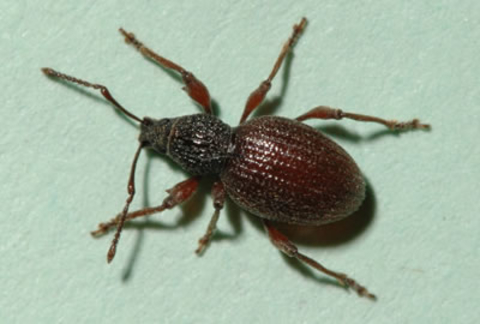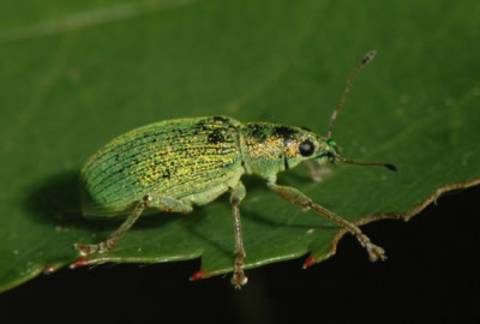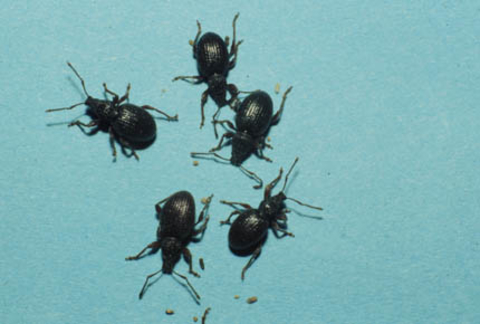Quick facts
- Weevils are small beetles that have noticeable snouts.
- They are often lightbulb- or pear-shaped.
- The immature, legless, grub-like larvae feed on plants.
- Adult weevils look for shelter in unfavorable weather conditions, especially when it is hot and dry.
- Weevils enter buildings by crawling through cracks or openings around foundations, doors and windows.
- They do not harm people or pets, or damage buildings or property, or infest food products.
- They are a temporary nuisance.
Strawberry root weevil (Otiorhynchus ovatus) is the most common home-invading weevil in Minnesota.
- You may find these weevils indoors from the end of June through August.
- They are attracted to moisture and are often found in sinks, bathtubs, water basins and similar places.
- They are about 1/4 inch long, black or dark brown with rows of pits along their back.
- Strawberry root weevils do not fly.
- Sometimes people confuse strawberry root weevils for ticks. But, weevils have six legs and ticks have eight.
- The larvae feed on the roots of strawberries, evergreens—such as arborvitae, spruce and Japanese yew—raspberries and other brambles, grapes and many other plants.
- Adults start to emerge in early summer and feed on the edges of leaves.
Other weevils
Sciaphilis asperatus
- It is 1/5 inch long with a dark brown or black body covered with brownish or tannish scales.
- When these scales are rubbed off, the weevil appears brown with irregular blackish markings.
- Adults are seen from May into November.
- These weevils feed at night on the leaves of sugar and red maple, yellow birch, hazel and hophornbeam.
- The larvae feed on the roots of these plants, although they are not considered a pest.
Barypeithes pellucidus
- It is reddish brown and between 1/8 to 3/16 inch long.
- Not much is known about this weevil's habits, although it appears to feed on trees.
- Adults are common in June and July.
Imported longhorned weevil
Calomycterus setarius looks similar to Sciaphilus asperatus but is a little smaller. This weevil is found primarily in southern Minnesota.
- It is about 3/16 inch long.
- It has a dark-colored body covered with grayish-brown scales.
- Missing scales give the appearance of irregular black patches.
- Adults are present in homes in July and August.
- Larvae feed on the roots of aster, clover and turfgrass, while adults chew on the leaves of a variety of annuals and perennials.
Polydrusus weevil
Polydrusus impressifrons is common in the northeast and north-central areas of Minnesota in forested sites.
- It is a slender 1/4 inch weevil with a dark-colored body covered with lime green, or iridescent-looking scales (different colors are seen in different angles of light).
- Weevils often appear to be green with black patches when scales are missing.
- Adults chew the leaves of rose, strawberry, birch, poplar, willow and apple from June through August, while larvae feed on the roots of these trees.
- The feeding damage only affects the appearance of plants.
How to get rid of weevils
Keeping out weevils is the best control method
- Caulk cracks and ensure snug-fitting screens and doors to reduce the number of weevils that may enter a building.
- Weevils, especially strawberry root weevils, are attracted to moisture. You can trap them in shallow pans of water placed around the foundations or walls of the house.
- These pans do not capture enough weevils to reduce the number of weevils entering homes.
Weevils inside homes
- When weevils are found indoors, physically remove them with a vacuum or broom and dustpan.
- Pesticides are not effective or necessary.
- These weevils are harmless and temporary and will go away on their own.
- Their numbers can vary from year to year.
- If you see many weevils one year, it does not mean that they will be a problem again the next year.
Generally, pesticides are not required.
- When there are high numbers of weevils, you can apply a pesticide, such as permethrin or bifenthrin, around the home's foundation.
- Pesticides available to the public are not very effective against weevils.
CAUTION: Mention of a pesticide or use of a pesticide label is for educational purposes only. Always follow the pesticide label directions attached to the pesticide container you are using. Be sure that the area you wish to treat is listed on the label of the pesticide you intend to use. Remember, the label is the law.
Reviewed in 2024





